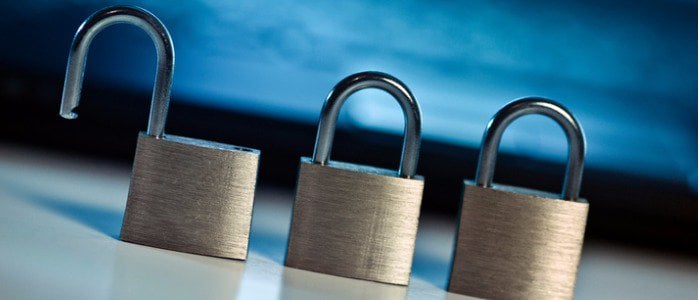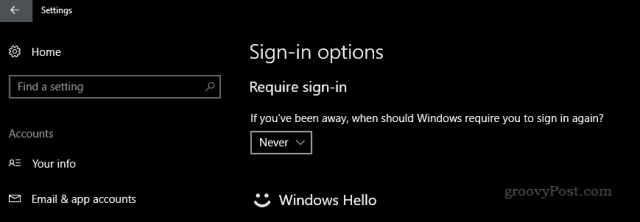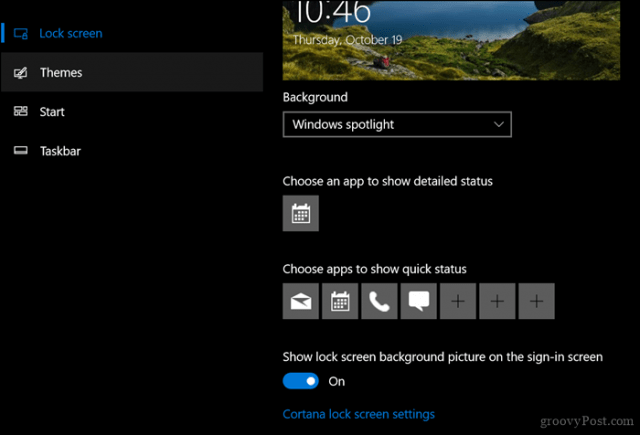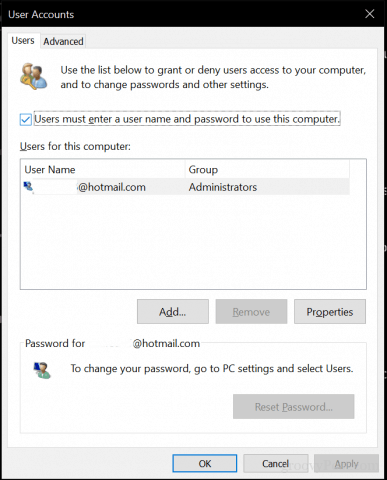How to Disable Sign-in Screen When You Wake Your Windows 10 Device

Tired of entering a password every time you wake your Windows 10 device? Well, disable it! Here’s how.
Letting your Windows 10 devices go to sleep or go into low power mode helps conserve battery power. But there is a minor annoyance each time you wake the device: you have to enter your PIN or password. If you own a Windows Hello device, it’s quick and easy since all you have to do is look at the screen, and immediately you are logged in. But for those like me with older devices, you have to enter credentials, which is so 20 years ago.
If you want to save yourself some time and hassle, you can set up your Windows 10 computer to wake from sleep without requiring a sign-in. Of course, this makes your device less secure, but if you’re willing to accept that risk, here’s how to make it happen.
Disable Sign-In Password Prompt When You Resume from Sleep in Windows 10
Open Start > Settings > Accounts > Sign-in options.
Click in the Require sign-in list box, then choose Never.


And you’re done! When waking your device, you should see your desktop how you left it.
If that’s not convenient enough for you, you can also disable the lock screen background. Go to Start > Settings > Personalization > Lock screen and toggle off “Show lock screen background picture“ on the sign-in-screen.


If you want to take it a step further, you can disable the password on startup, but again, this significantly increases the chances of unauthorized individuals getting into your computer.
Press Windows key + R
Type: control userpasswords2
Hit Enter.
Uncheck “Users must enter a user name and password to use this computer.” Click Apply then OK to confirm changes.


Applying these changes to sign-in should be dependent on your environment; if you are working at home alone or with family, it’s not a big deal. Just don’t take the risk of doing this in public places where you might have to leave the device unattended. If you want the best of both worlds of keeping your device secure without typing passwords, check out a feature called Device Lock. Starting in Windows 10 Creators Update, this function lets you use your Bluetooth-paired smartphone to keep your device locked when you step away.
So, those are your options to save you those extra few seconds from having to enter a password every time. Got any other helpful tips? Please share them in the comments!
5 Comments
Leave a Reply
Leave a Reply

Biagio Vella
October 21, 2017 at 10:03 pm
Hi Andrea,
You are making an excellent work with this daily G|Post from which we are learning a lot.
Lately I have upgraded to Windows 10 Fall Creators Version 1709.
I am having a slight issue whenever I shut down – there always remains an application or file which is
said to be still opened – but in fact I am sure that I have closed everything and also Task Manger show that there are no more opened files. I don’t know which is the file/program which remains still open and I have to click on “shutdown anyway” every time. I thank you in anticipation for any information you may give me in order to eliminate this issue.
All my best regards
Mike Matlock
October 27, 2017 at 12:34 pm
I have tried every program you have suggested to get anay from having to enter a password. I can not get any of them to work
Mark
June 2, 2020 at 10:46 pm
How do you disable the lock screen preview picture?
Then, my computer switches to a screen where i would have to type in a password, but with the password on wake disabled I still have to hit the space bar or some other key to enter. I want to get rid of that pesky OK button. I have to hit the space bat twice to gain access to my desktop. Very frustrating.
Trev
November 5, 2020 at 1:22 pm
Like the other 2 people, this doesn’t work
Chad
December 16, 2021 at 7:30 am
Hi – I’ve tried everything suggested here, but I still get the sign in screen after the computer has been off for a day or two.